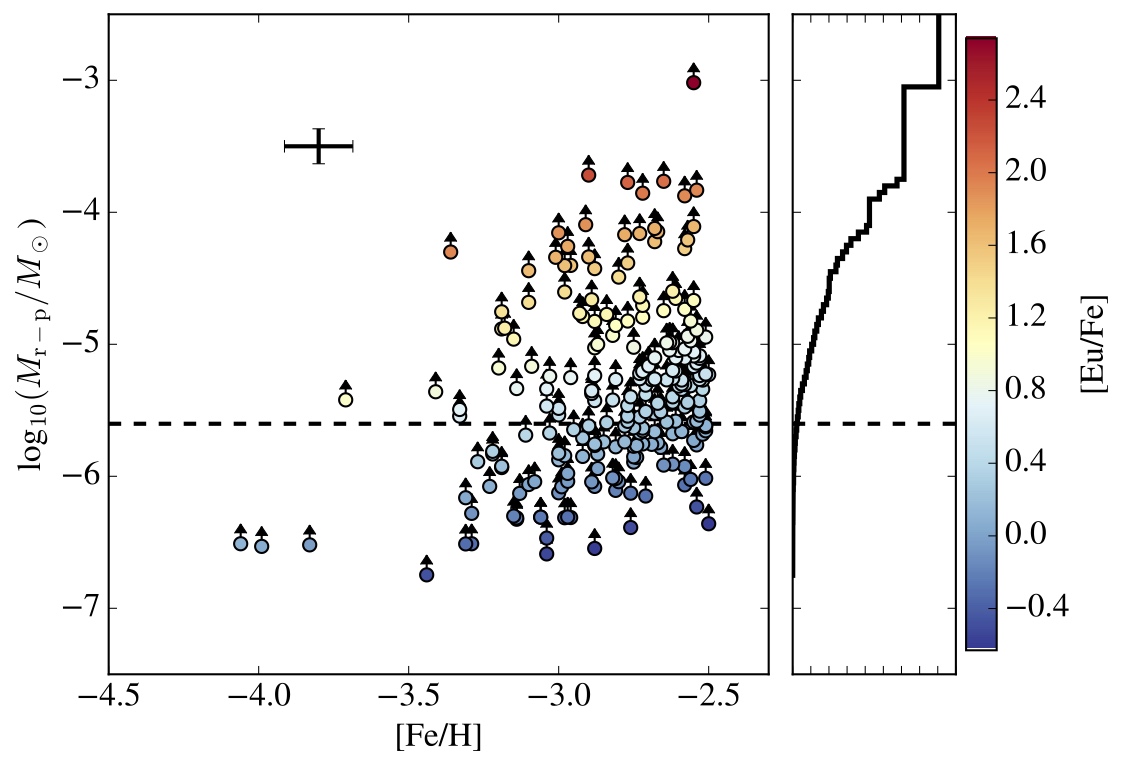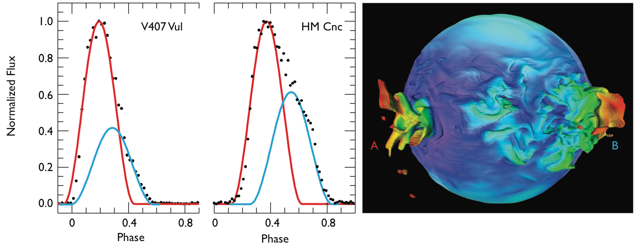Research
Here is a partial description of my research interests, which include nuclear astrophysics, binary stellar evolution, and most recently supernova cosmology. A full list of publications can be found via the following links:
r-Process Nucleosynthesis
 The r-process is the nucleosynthetic pathway responsible for the creation of roughly half of the elements heavier than iron. Though we have known the physical conditions required for the r-process to occur since the late 1950s, the astrophysical site(s) where these conditions are realized has
been debated for decades. I am interested in utilizing astrophysical observations and theory to try to distinguish between various proposed sites. In addition to the numerous recent indirect lines of evidence implicating a relatively rare r-process event, the binary neutron-star merger discovered in 2017 has confirmed the viability of this long proposed channel while also raising many new and interesting questions. The figure shown is the key figure of our 2018 paper in which we utilize observations of heavy element abundances in metal-poor stars to place strict lower limits on the mass of r-process elements synthesized per event. Future observations of neutron-star mergers as well as metal-poor stars will continue to shed light on the dominant progenitor channel(s) throughout the history of the universe.
The r-process is the nucleosynthetic pathway responsible for the creation of roughly half of the elements heavier than iron. Though we have known the physical conditions required for the r-process to occur since the late 1950s, the astrophysical site(s) where these conditions are realized has
been debated for decades. I am interested in utilizing astrophysical observations and theory to try to distinguish between various proposed sites. In addition to the numerous recent indirect lines of evidence implicating a relatively rare r-process event, the binary neutron-star merger discovered in 2017 has confirmed the viability of this long proposed channel while also raising many new and interesting questions. The figure shown is the key figure of our 2018 paper in which we utilize observations of heavy element abundances in metal-poor stars to place strict lower limits on the mass of r-process elements synthesized per event. Future observations of neutron-star mergers as well as metal-poor stars will continue to shed light on the dominant progenitor channel(s) throughout the history of the universe.
Common-Envelope Evolution
 Observations of compact binaries require a significant decrease in their current orbital separations compared to their birth separations
. The most often invoked mechanism is the so called "common-envelope" (CE) evolution. A CE is induced when unstable mass transfer
within the binary leads to both stars becoming embedded in a single gaseous envelope. The ejection of this envelope comes largely at the cost of the
orbital binding energy of the system, leading to significant tightening of the binary.
While CE events are not particularly rare, they happen very quickly and are thus
mostly studied theoretically through hydrodynamical simulations. The figure shown here is from
our 2017 paper in which we model the progenitor system
of a fortuitous stellar merger in M31 in order to learn about the onset of a CE event.
Observations of compact binaries require a significant decrease in their current orbital separations compared to their birth separations
. The most often invoked mechanism is the so called "common-envelope" (CE) evolution. A CE is induced when unstable mass transfer
within the binary leads to both stars becoming embedded in a single gaseous envelope. The ejection of this envelope comes largely at the cost of the
orbital binding energy of the system, leading to significant tightening of the binary.
While CE events are not particularly rare, they happen very quickly and are thus
mostly studied theoretically through hydrodynamical simulations. The figure shown here is from
our 2017 paper in which we model the progenitor system
of a fortuitous stellar merger in M31 in order to learn about the onset of a CE event.
Accretion Physics of Ultra-Compact Binaries
Ultra-compact binaries are systems with orbital periods of less than one hour and consisting of two
compact stellar remnants. They allow us to study novel astrophysical phenomena due to their ultra-short periods and
their hydrogen-deficient nature. They include double white dwarfs (WDs), double neutron stars (NSs), WD-NS binaries, and
 black holes with NS or WD companions. These systems lose angular momentum via the emission of gravitational-waves (GWs),
and those that do not immediately merge will survive as an interacting (by accretion) ultra-compact binary (IUCB). IUCBs
serve as test-beds of physics at extreme densities and temperatures, allowing us to probe matter under conditions we cannot
recreate in terrestrial laboratories. These systems contain information about the physics of nuclear burning, angular
momentum redistribution, the effects of non-linear tides, and radiative transport that we attempt to understand through
observation and modeling. I am currently working
on modeling the direct impact accretors HM Cancri and V407 Vulpeculae
using FLASH, a 3D AMR hydrodynamics code, in order to better understand the mass transfer in these systems.
black holes with NS or WD companions. These systems lose angular momentum via the emission of gravitational-waves (GWs),
and those that do not immediately merge will survive as an interacting (by accretion) ultra-compact binary (IUCB). IUCBs
serve as test-beds of physics at extreme densities and temperatures, allowing us to probe matter under conditions we cannot
recreate in terrestrial laboratories. These systems contain information about the physics of nuclear burning, angular
momentum redistribution, the effects of non-linear tides, and radiative transport that we attempt to understand through
observation and modeling. I am currently working
on modeling the direct impact accretors HM Cancri and V407 Vulpeculae
using FLASH, a 3D AMR hydrodynamics code, in order to better understand the mass transfer in these systems.
Asteroseismology and the Helium Core Flash
 The helium core flash (HCF), i.e. the runaway ignition of partially degenerate helium in lower mass stars after they have exhausted their central hydrogen,
is a very well studied event in stellar evolution theory. However, due to the enshrouding envelope of the red giant star in which it takes
place, they are extremely difficult to detect by traditional means. Working with Lars Bildsten,
Bill Paxton, and Kevin Moore, we proposed that stars actively undergoing the HCF may be identifiable by using
asteroseismology. Asteroseismology is the study of large scale oscillations throughout a star in order to infer information about its interior,
similar to how we study the interior of our own planet. With the advent of extremely high precision photometry telescopes such as Kepler,
we are now beginning to be able to probe deep into the interiors of red giants. The figure shown is from our 2012 paper and demonstrates how our models traverse the space of observables while undergoing the HCF.
The helium core flash (HCF), i.e. the runaway ignition of partially degenerate helium in lower mass stars after they have exhausted their central hydrogen,
is a very well studied event in stellar evolution theory. However, due to the enshrouding envelope of the red giant star in which it takes
place, they are extremely difficult to detect by traditional means. Working with Lars Bildsten,
Bill Paxton, and Kevin Moore, we proposed that stars actively undergoing the HCF may be identifiable by using
asteroseismology. Asteroseismology is the study of large scale oscillations throughout a star in order to infer information about its interior,
similar to how we study the interior of our own planet. With the advent of extremely high precision photometry telescopes such as Kepler,
we are now beginning to be able to probe deep into the interiors of red giants. The figure shown is from our 2012 paper and demonstrates how our models traverse the space of observables while undergoing the HCF.
 https://orcid.org/0000-0002-9946-4635
https://orcid.org/0000-0002-9946-4635